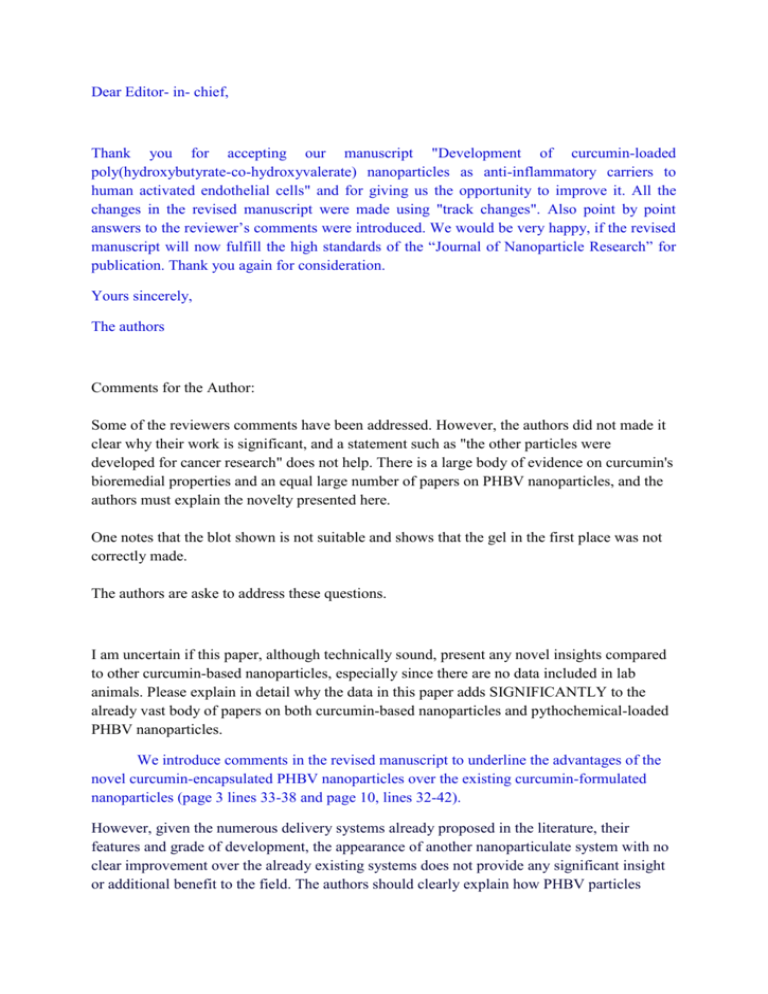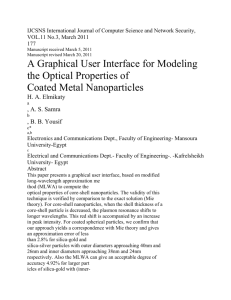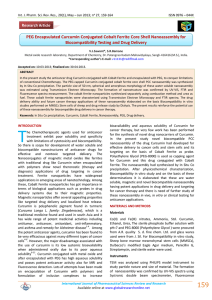Dear Editor- in- chief, Thank you for accepting our manuscript
advertisement

Dear Editor- in- chief, Thank you for accepting our manuscript "Development of curcumin-loaded poly(hydroxybutyrate-co-hydroxyvalerate) nanoparticles as anti-inflammatory carriers to human activated endothelial cells" and for giving us the opportunity to improve it. All the changes in the revised manuscript were made using "track changes". Also point by point answers to the reviewer’s comments were introduced. We would be very happy, if the revised manuscript will now fulfill the high standards of the “Journal of Nanoparticle Research” for publication. Thank you again for consideration. Yours sincerely, The authors Comments for the Author: Some of the reviewers comments have been addressed. However, the authors did not made it clear why their work is significant, and a statement such as "the other particles were developed for cancer research" does not help. There is a large body of evidence on curcumin's bioremedial properties and an equal large number of papers on PHBV nanoparticles, and the authors must explain the novelty presented here. One notes that the blot shown is not suitable and shows that the gel in the first place was not correctly made. The authors are aske to address these questions. I am uncertain if this paper, although technically sound, present any novel insights compared to other curcumin-based nanoparticles, especially since there are no data included in lab animals. Please explain in detail why the data in this paper adds SIGNIFICANTLY to the already vast body of papers on both curcumin-based nanoparticles and pythochemical-loaded PHBV nanoparticles. We introduce comments in the revised manuscript to underline the advantages of the novel curcumin-encapsulated PHBV nanoparticles over the existing curcumin-formulated nanoparticles (page 3 lines 33-38 and page 10, lines 32-42). However, given the numerous delivery systems already proposed in the literature, their features and grade of development, the appearance of another nanoparticulate system with no clear improvement over the already existing systems does not provide any significant insight or additional benefit to the field. The authors should clearly explain how PHBV particles could make a real difference in the actual context of curcumin delivery and the relevance of the design of these particles. SPECIFICS 1. This paper requires major English editing. Words are used inappropriately (different meaning); sentence construction several times results in unambiguous statements; punctuation is absent or incorrectly used; incorrect use of “that” and “which”, past and present tense used heterogeneously, etc., etc., etc. EXAMPLES a. Page 7: “To dissociate between the internalized…” should be “To differentiate between the internalized…” b. Page 7: “Nanocarriers such as liposomes and polymeric nanoparticles need to be internalized” should read “Nanocarriers, such as liposomes and polymeric nanoparticles, need to be internalized” We checked the manuscript for English editing and modified the sentences according to the reviewer suggestion. 2. “The diminished internalization observed for high CmPN concentrations can be explained by a saturation ofthe cells for further internalization”. This is unambiguous and certainly no explanation. Elaborate and explain what caused the staturation. This comment about saturation have been addressed in the first revision of the manuscript and we removed this statement. We kindly ask the reviewer to check the revised manuscript. 3. 3.5. CmPN suppress phosphorylation of p38MAPK in HEC: Here you state that Camacho-Barquero et al. 2007 showed that the p38MAPK pathway was inhibited by curcumin in cultured cells, but do not discuss how your results compare to the results of the aforementioned paper. The reviewer comment was considered and, since in the paper cited is shown that curcumin inhibits p38 MAPK in chronic colonic inflammation in rats, we introduced in the revised manuscript references on the inhibition of p38 MAPK pathway by curcumin in endothelial cells [1, 2] . 4. Why was only p38MAPK tested and not several of the other pathways that curcumin affects?? It is a bit thin presenting just these results. Our purpose was to prove that by encapsulating Cm into PHBV nanoparticles, its anti-inflammatory characteristics is preserved. Therefore, we have chosen one signaling pathway that was previously reported to be inhibited by curcumin. 5. Generally, this paper is not well written. There is very little discussion on how the obtained results can be placed in light of what others have found. Amend! We amended the discussion section and we compared our results with that obtained by others. 6. Fig 3: bar in (a) is difficult to read; (c) is unacceptable. It looks as if a photo of a computer screen was made. Amend! We improved the quality of the figure. We kindly invite the reviewer to revise the modified figure. 7. Fig 4: why write 24h etc on the x-axis when the axis legend already states: times (hours) . We considered this suggestion and modified the figure 4. 8. Fig 7: bad quality. The color on the axes should be removed, the letter size increased and the general resolution as well. Do NOT use yellow in figures on a white background, it is difficult to discern. We modified the figure according to the reviewer suggestion. 9. Fig 8: Blot is substandard. The lanes are distorted and a better blot should be presented. Furthermore, I would like to see the whole blot including markers. Please find below another blot that we included in the revised figure 8. Also, on the left we included the molecular markers. We thank the reviewers for improving the language and for the constructive suggestions that we hope have improved the manuscript. The authors References 1. 2. Kim, Y.S., et al., Curcumin attenuates inflammatory responses of TNF-alpha-stimulated human endothelial cells. J Cardiovasc Pharmacol, 2007. 50(1): p. 41-9. Binion, D.G., M.F. Otterson, and P. Rafiee, Curcumin inhibits VEGF-mediated angiogenesis in human intestinal microvascular endothelial cells through COX-2 and MAPK inhibition. Gut, 2008. 57(11): p. 1509-17.








